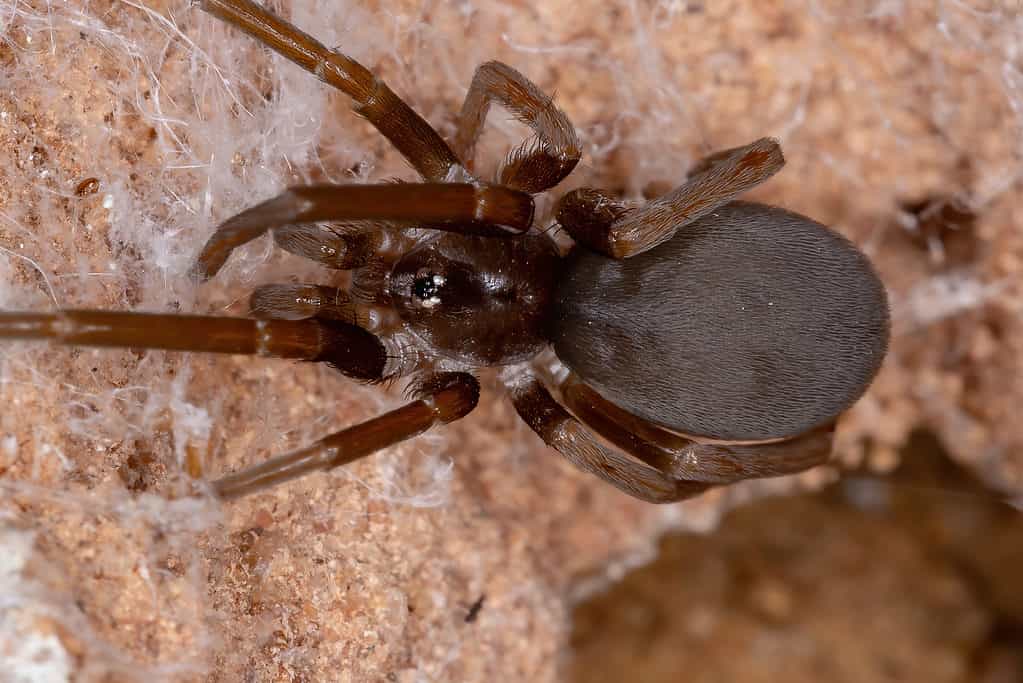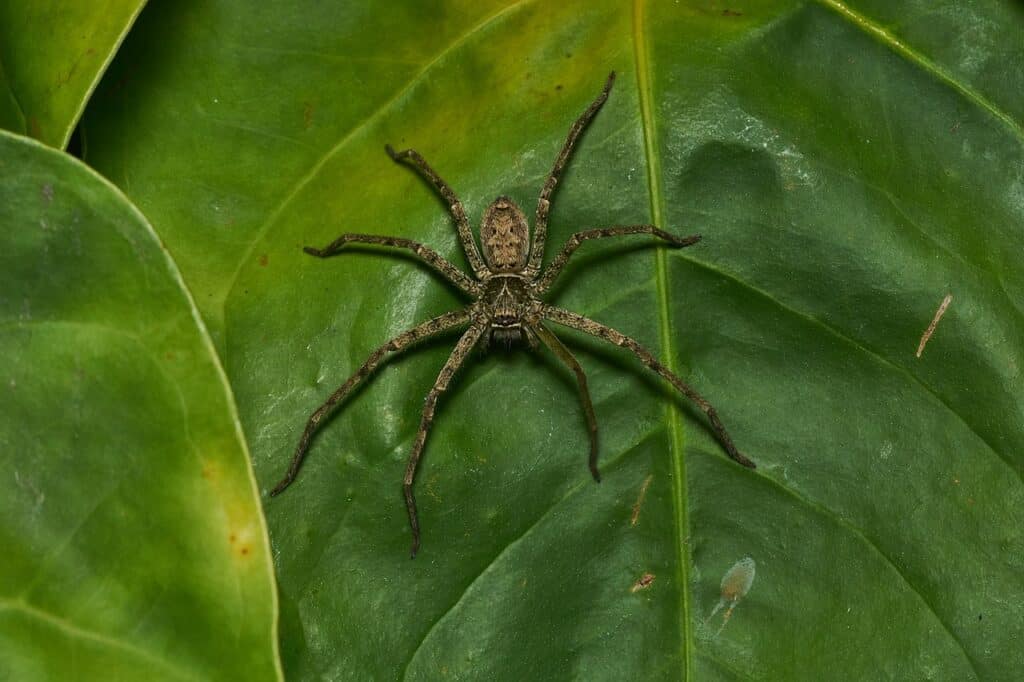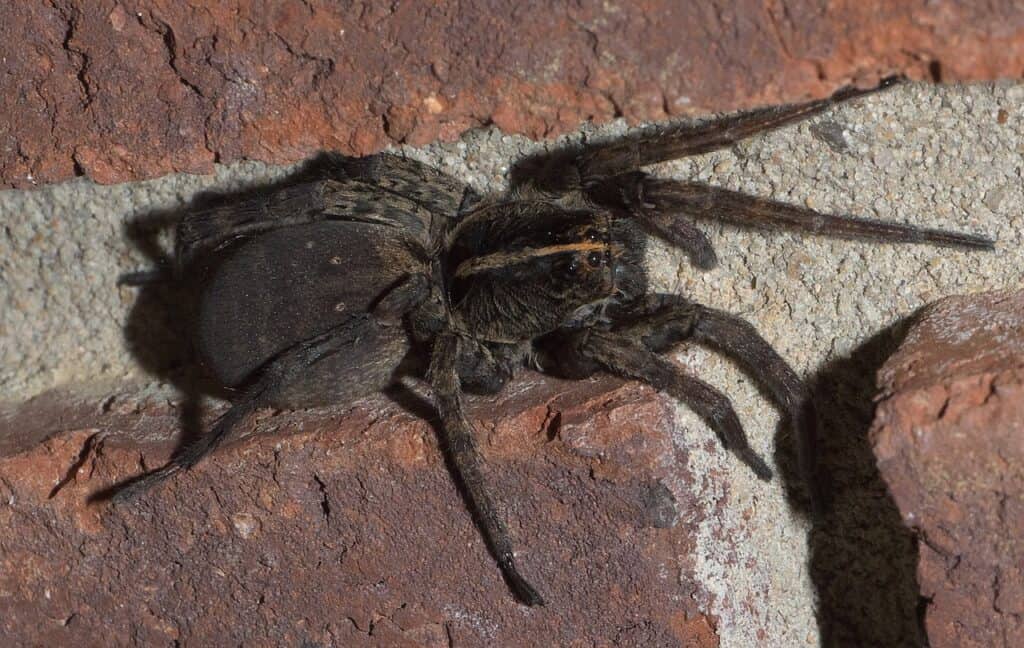Spiders are mysterious and intriguing critters that fascinate some and terrify others. Mississippi is home to around 27 spider species, and luckily only four of those have venom that can harm humans.
From their subtle, earthy coloration to their mysterious behavior, brown spiders have a captivating presence. Join us as we journey through the Magnolia State’s forests, fields, and gardens to discover the hidden world of spiders. Due to their unique habitats and fascinating behaviors, they will leave you in awe. Whether you’re a curious nature lover or a spider enthusiast, learning about the brown spider species in Mississippi will help you identify the dangerous ones from the friendly ones.
Brown Recluse Spider (Loxosceles reclusa)

The brown recluse is infamous for its potent venom that can cause significant tissue damage in humans.
©Physics_joe/Shutterstock.com
The brown recluse spider, belonging to the Sicariidae family, often elicits fear and fascination. Found throughout the south-central and Midwestern United States, including Mississippi, these spiders are known for their distinctive coloration and dangerous venom. In fact, they are one of the most venomous spiders in the Americas. However, this spider rarely bites humans due to its “reclusive” nature.
Appearance
The size of these spiders can vary. They typically measure between 1/4 to 1/2 an inch in length, with legs extended, making them about the size of a U.S. quarter. As their name suggests, these spiders range from dark brown to tan.
Unlike many other spiders, the brown recluse has no stripes, bands, or mottling, giving it a smooth and uniform appearance. Additionally, these spiders have long and thin legs that lack any conspicuous spines.
Behavior
The brown recluse is named for its shy personality and solitary behavior. It spends its days in hidden, dark locations, only venturing out at night in search of food. However, under certain circumstances, such as hunger, overcrowding, or exposure to pesticides, this spider may be spotted roaming around during the day.
When threatened, the brown recluse spider often retreats to avoid confrontation.
Habitat
In its natural habitat, Loxosceles reclusa can be found nestled in cozy cracks and crevices, such as under logs, rocks, and dead tree bark.
When it comes to human structures, they prefer to live within walls and behind stored items that provide warmth and dryness.
Eating Habits
Their diet consists primarily of small insects and other spiders. Unlike web-weaving spiders, the brown recluse is a hunting spider. It uses its agility to chase down prey like a predator. Its venom is used to subdue its prey.
Venom
The brown recluse is infamous for its potent venom that can cause significant tissue damage in humans. Although serious injury and death are rare, the venom can be particularly dangerous in severe cases. Additionally, the bite is often not felt immediately.
Unfortunately, there is no cure for a brown recluse bite. The best course of action is to seek medical treatment and prevent infection.
Fun Facts About Brown Recluses
- They can survive for extended periods without food.
- Brown recluses prefer to feed on dead insects.
- They display cannibalistic behavior, feeding on members of their own species.
Southern House Spider (Kukulcania hibernalis)

Females and spiderlings have a unique talent for building gigantic webs.
©Vinicius R. Souza/Shutterstock.com
The southern house spider, a member of the Filistatidae family, is a common sight in homes and gardens. Its range spans from South America to the southern United States, and it’s familiar to many Mississippi residents.
Appearance
With color ranging from plain brown to grayish brown, this species stands out in its simplicity. Despite their similar coloring, males and females exhibit significant differences in size and shape.
Males are slimmer and boast a body length of only 0.3 to 0.5 inches, making them much smaller than females. In contrast, females are robust and rounded, with a body length of 0.5 to 0.7 inches and a broader cephalothorax.
Behavior
Like most spider species, the southern house is known for its solitary behavior. However, because these arachnids create webs that span vast areas, it’s not uncommon to see multiple individuals sharing the same web, resulting in a “colony.” Females and spiderlings have a unique talent for building these gigantic webs.
These colonies can be home to hundreds of spiders! They are unique in their behavior, as the individuals within them are more tolerant of each other than when alone.
Habitat
This species likes the cozy corners of buildings, such as dark nooks and crannies of window sills, shutters, and overhangs. As its name suggests, the southern house spider is commonly found in homes, barns, sheds, and other human-inhabited areas. They tend to make their homes in the masonry of these structures, where they can thrive in the shadows. They can also be found nestled under tree bark.
Eating Habits
Southern house spiders have adaptive feeding habits, as they opportunistically prey on available insects in their environment. Their eating patterns are not fixed, and these spiders can go without food for extended periods in times of scarcity.
Venom
Despite resembling the dangerous recluse spider species, southern house spiders pose no harm to humans. Their bite is rare and not aggressive, and their venom is not potent enough to cause any significant medical concerns.
Fun Facts About The Southern House Spider
- Southern house spiders also go by the name southern crevice spiders or crevice spiders.
- They are fast-moving creatures known for actively chasing their prey.
- Males have a tendency to wander, while females tend to stay close to their webs and are less mobile.
Starbellied Orb Weaver (Acanthepeira stellata)

The 10-12 points that protrude from different parts of its abdomen are the starbellied orb weaver’s most defining characteristics.
©Judy Gallagher, CC BY 2.0 <https://creativecommons.org/licenses/by/2.0>, via Wikimedia Commons – Original / License
The starbellied orb weaver, scientifically named Acanthepeira stellata, is a highly unique spider species belonging to the Araneidae family. This spider ranges from the northern regions of Canada to the southern regions of Mexico.
Appearance
Acanthepeira stellata has an incredibly strange and recognizable appearance. Its brown body displays varying shades of light and dark. The 10-12 points that protrude from different parts of its abdomen are its most defining characteristics. These points create a star-like appearance. Adding to its distinctive look, two of the spider’s eyes are situated on elevated points. It’s a fascinating species of spider to observe.
The starbellied orb weaver measures between a quarter to five-eighths of an inch in size. Like many spider species, the males are significantly smaller than the females.
Behavior
The starbellied orb weaver is a stationary hunter that does not wander. Instead, it patiently waits for its prey to become entangled in its web. If the spider does leave its web, it remains close by, concealed within the protective surroundings of a nearby hiding spot. These may camouflage on or under rolled-up leaves or the branches of a plant.
Habitat
Acanthepeira stellata lives in prairies, meadows, grasslands, and other open, sun-filled habitats. This species weaves vertical, wheel-shaped webs about 4 feet from the ground that measure around one foot in diameter.
Eating Habits
The diet of the starbellied orb weaver primarily consists of flying insects, such as beetles, moths, flies, and wasps. When these insects become ensnared in the sticky web, the orb weaver bites them, releasing its paralyzing venom.
Venom
The venom of Acanthepeira stellata is not potent enough to pose a significant threat to humans or pets unless a severe allergic reaction occurs. The bite of this spider is typically less severe than a bee sting. It is rare for humans to be bitten due to the spider’s natural defense mechanism of playing dead when threatened.
Fun Facts
- The starbellied orb weaver is considered a helpful species due to its hunting of flying insects.
- The spider’s venom liquefies the insides of its prey, allowing it to consume the fluid contents.
- Orb weavers are a diverse group with over 3,000 species found globally.
Pantropical Huntsman (Heteropoda venatoria)

The pantropical huntsman spiders and related species feed on a variety of insects, including cockroaches and other household pests.
©© 2017 Jee & Rani Nature Photography / CC BY-SA 4.0 via Wikimedia Commons – Original / License
As a member of the Sparassidae family, Heteropoda venatoria is commonly known as the giant crab spider or cane spider.
Appearance
The Heteropoda venatoria is characterized by its distinct brown color and flat body shape. It’s length ranges from 0.8 to 1 inch and it has a width of 3 to 4 inches, including the legs. The female may exhibit a slightly bigger abdomen compared to the male. However, the latter has more extended legs and more prominent pedipalp tips.
This species’ body is smooth with little to no hair. Its legs possess stiff setae that are each distinguished by a black dot.
Behavior
Pantropical huntsman spiders, like other wandering spiders, do not rely on webs to catch their prey. Instead, they have developed exceptional speed and formidable chelicerae, or jaws, which they use to capture their insect prey.
This unique hunting method sets them apart from other species and highlights their adaptability in finding food in their environment.
Habitat
These spiders have a diverse range of habitats and can be found in various environments. They can be located under loose tree bark, in crevices on rock walls, and within logs. These spiders can also be discovered beneath rocks on the ground and on various types of foliage.
Eating Habits
The pantropical huntsman spiders and related species feed on a variety of insects, including cockroaches and other household pests. This makes them a valuable asset in controlling the populations of these unwanted insects.
Their diet also consists of butterflies and moths, demonstrating their versatility in finding food sources.
Venom
The venom of the pantropical huntsman spider is potent enough to cause pain, but it is not dangerous to humans. It is important to note that different individuals may have varying levels of sensitivity to spider bites, and some may experience more severe symptoms than others.
Fun Facts
- Over 1,200 species of huntsman spiders exist.
- They prey on scorpions and bats.
- They are sensitive to cold and can only live outdoors in warm climates.
Wolf Spider (Lycosidae spp.)

Some of their legs can reach up to a jaw-dropping 3 inches!
Wolf spiders, known for their cunning hunting skills and agility, are a species that belong to the family Lycosidae.
Appearance
These creepy crawlies come in a range of browns and blacks and boast distinctive light and dark stripes. Their eyes are a distinguishing feature, arranged in three rows.
Most species sport a body size ranging from a quarter of an inch to over an inch and a half. Some of their legs can reach up to a jaw-dropping 3 inches! It’s no wonder they often get mistaken for tarantulas.
Behavior
Wolf spiders are solitary hunters that roam the night in search of their next meal. Unlike other spider species, they don’t spin webs and prefer to live alone. These nocturnal creatures are expert stalkers, sneaking up on their prey with stealth and precision.
Although they primarily dwell on the ground, these versatile predators have the ability to climb trees and other objects if the need arises.
Habitat
Wolf spiders are highly adaptable creatures, capable of thriving in a variety of habitats with a sufficient supply of insects. They can be found in all corners of the world, from grasslands to farm fields and even in meadows.
Eating Habits
Wolf spiders are fierce predators that hunt a diverse range of small invertebrates, from crickets and ants to grasshoppers and even other spiders. Their hunting method, which involves chasing and pouncing on their prey, is reminiscent of the wolves that inspired their name.
When a wolf spider successfully catches its prey, it mashes it into a ball or injects liquefying venom that turns internal organs into a “smoothie.” The wolf spider’s diet is not limited to insects; some larger species have been known to take down small lizards and frogs.
Venom
Wolf spiders are not considered dangerous to humans, as their venom is not poisonous. However, some people may be allergic to the venom. If so, mild to moderate symptoms such as pain, swelling, and itching around the bite site may be present. Despite this, wolf spider bites are not life-threatening, and the effects usually fade quickly.
Fun Facts
- Wolf spiders are expert burrow builders, creating underground homes to protect themselves.
- With eight eyes, wolf spiders have exceptional eyesight, making them skilled hunters in the dark.
- Due to their distinctive appearance and fascinating behavior, wolf spiders have become popular pets among spider enthusiasts.
Up Next
- Garden Spiders in Texas: 29 Common Spiders in Gardens
- Joro Spider vs Banana Spider: What Are the Differences?
- Good Spiders vs Bad Spiders: Which Spiders Should You Leave in Your House?
The photo featured at the top of this post is © iStock.com/CathyKeifer
FAQs (Frequently Asked Questions)
Are there venomous spiders in Mississippi?
There are a few spiders in Mississippi that contain venom that is dangerous to humans. The most venomous spiders in Mississippi are the Northern Yellow Sac Spider (Cheiracanthium mildei), The Brown Widow (Latrodectus geometricus), The Black Widow (Latrodectus mactans/Latrodectus various), and the Brown Recluse (Laxosceles reclusa).
Thank you for reading! Have some feedback for us? Contact the AZ Animals editorial team.







